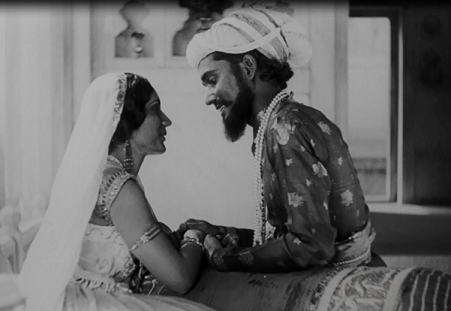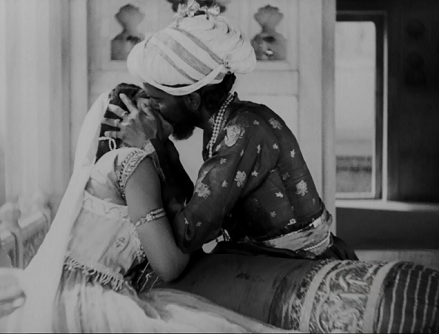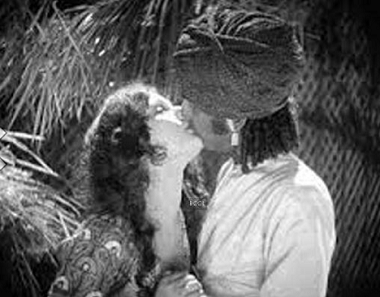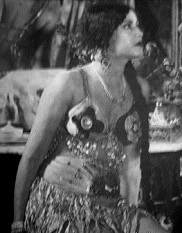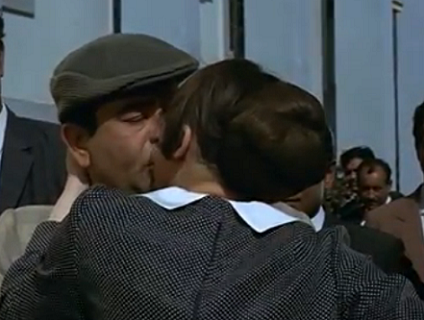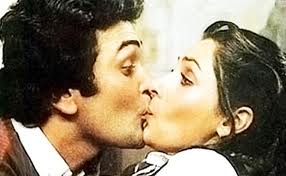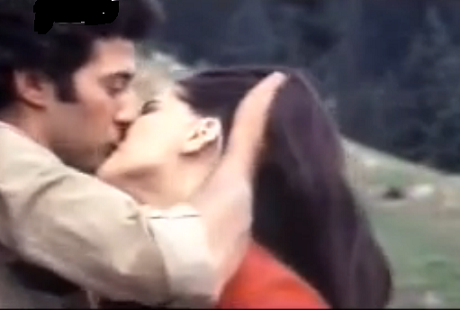Kissing in Hindi-Urdu cinema
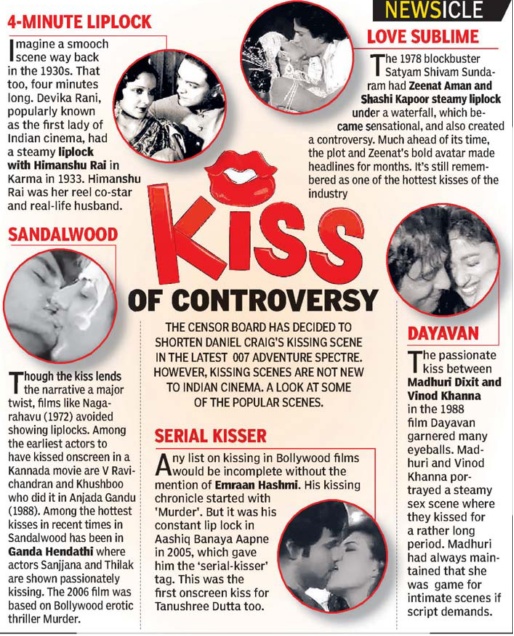
This is a collection of articles archived for the excellence of their content.
You can update or correct this page, and/ or send photographs to the Facebook page, Indpaedia.com. All information used will be duly acknowledged. |
This page is under construction It might have some references to non-Hindi cinema. If material grows, there might be separate pages on Kissing in each non-Hindi cinema
Contents |
The 1920s
The screen kiss was common in silent films before it became taboo shortly after the coming of the talkies. (A still from A Throw of Dice is seen alongside.)
The 1930s
1932 - Zubeida scandalised audiences with her film Zarina, in which she was scantily clad and had kissing scenes.
Karma (1933) featured one of India’s early onscreen kisses: legitimised only somewhat by the fact that heroine Devika Rani was kissing her real life husband, actor Himanshu Rai. At four minutes it probably remains the longest kissing scene in the history of Indian cinema. For the photograph see Indian cinema: 1930-39. At some stage in the 1930s, kissing was banned by the Indian censors.
1936: Film historian Ashok Da Ranade has written that in 1944 a film called Shokh Dilruba was released, with as many as 150 kisses, one of which was 13 minutes long. (See p.121 of his book "Music Beyond Boundaries.") The problems with this statement are that i) kisses had disappeared by the mid- or late thirties from the Indian screen, under censorship restrictions; and ii) it has not been possible to locate a film by this name in 1944.
Google searches as well as the 'Geet Kosh' point to a Shokh Dilruba (Dir JP Advani)that was made in 1936, by when kisses had more or less peaked in Indian cinema and were about to vanish. Khursheed was the heroine, Nazir the hero, and Yasmin a supporting actress. malayalasangeetham.info seems to support Indpaedia's theory that the Shokh Dilruba of 1936 was the 'kissing film' that we are talking of.
The [four? five?] kissless decades
(These decades roughly were: the mid-1930s to 1978 and 1978 to the early 1990s)
WHY BOLLYWOOD GAVE THE KISS A MISS
Rachel Dwyer The Times of India Nov 09 2014
Among the many myths about Indian cinema, one of the most prevalent is that kissing is banned. However, early films such as Zarina (dir. Ezra Mir, 1932), which caused such controversy it was removed from the circuits, featured 86 kisses. There is no legal prohibition on kissing in Indian cinema but it largely vanished from the 1940s until it reappeared in several films in the 1990s, perhaps the most famous being Aamir Khan and Karisma's long smooch in Raja Hindustani (dir.Dharmesh Darshan 1996). So what happened to the onscreen kiss in those five decades? While the kiss -the lip-to-lip erotic kind -was absent from Hindi cinema during these years it was implied as two flowers touched, or when the camera shows a couple reflected in a pool which suddenly ripples as they move closer to each other or the camera simply moved away as they drew near.
There were also many songs about kissing, one of my personal favourites being Salman Khan, clad in a vest, emerging from a river in full sight of a troupe of dances, the males pulling their trousers down in one dance step while our hero sings (in English), `One two three, give me a kiss' to Manisha Koirala.
Kissing is present in the Kamasutra so it cannot be dismissed as something westernized, but rather it is seen in India as something to be done in private rather than in public.The boundary between the private and the public in film is shifting and porous, as is the behaviour of stars, many of whom refuse to kiss (Shah Rukh, until Jab Tak Hai Jaan, dir.Yash Chopra, 2012), while others, such as Emraan Hashmi, are famous for their kissing. Filmmakers are also wary of the censors, perhaps fearing the kiss will be cut, and even passionate bedroom scenes often avoid kissing -at least lip to lip.
Yet it was during the kiss-free years that Hindi cinema evolved its own ways of showing romance, love and eroticism. Landscapes and other locations, costumes (including the `wet sari') and symbols set the scene -a log cabin indicating privacy and intimacy between the couple, from which the male star would leap to yell `Yahoo!' Dialogues, which were oftquoted outside the movie hall, developed a language of love blending Hindi, Urdu, Hinglish, Punjabi and English, although preferring the declaration of love to be in English: `I love you.' The film song supplemented its lyrics with dance steps which could be romantic, erotic or suggestive, and possibly obscene.
This focus on language in Hindi cinema, whether in its dialogues or lyrics, is perhaps the key to the kiss or, rather the missing kiss. You can't kiss and talk; and you certainly can't kiss and sing. Perhaps it is more romantic or erotic to say, `I love you' than it is to kiss. The rise of onscreen kissing in recent years may be more to do with shifting domains of the private and the public. Hindi cinema is perhaps not so much breaking taboos but rather creating an intimate space for the onscreen couple, which is emulated in real life. This may be helped by changing viewing practices as audiences watch films in less socially differentiated movie halls, the multiplexes being mixed venues with no hierarchy of seating. While some films remain popular viewing for the whole family, others are watched by groups of young people, or by couples, and are increasingly viewed on small screens which create a more private setting.
Kissing also focuses the audience's attention on the couple more than the family unit. Older films often had the couple coming together before the interval then having to find a place in the family in the second half. Perhaps films now are less concerned with the couple and the family and more with ideas of modern love and romance as a means of self-fulfilment and consumerism. Yet Hindi cinema continues to show both of these views as part of its important negotiation between the modern and the traditional.
Kissing in older Hollywood films was a representation of the erotic and suggested much more. Now that films show intimate scenes, the kiss is no longer so important and this may be the case also for Hindi cinema. The most erotic moment in Hindi cinema is often said to be the encounter between Prince Salim (Dilip Kumar) and Anarkali (Madhubala) in Mughal-eAzam (dir. K. Asif, 1960) when he brushes her face with a feather. The truly erotic may be that which is not seen but which is suggested and then shaped in the audience's imagination.Dialogues of romance can be repeated and songs can be sung in other contexts. But a kiss is only ever a kiss.
Dwyer is professor of Indian Cultures & Cinema at SOAS, University of London, an authority on Yash Chopra’s films and the author of several authoritative books on Hindi-Urdu cinema '
The 1940s and 50s
Chaste films. No kisses.
This enervated western writers like the one below:
1944: Romancing with everything but the kiss
Beverley Nichols, Verdict on India (1944) 8ate wrote in 1944:
It was late in the afternoon when we returned to the studio.
A love scene was in progress. At least, it appeared to be a love scene, but somehow it never seemed to get going.
The village maiden was making sheep's eyes at a young man with a swelling chest. If ever a girl was saying 'Come on' she was saying it, and if ever a chest were swelling because its owner was activated by 'Coming on' instincts, this was the chest in question.
But nothing happened, nothing, that is to say, in the nature of a clinch. The eyes shouted 'come on' in even louder accents, the chest swelled to bursting point (till, in sympathy, one found oneself puffing out like a pouter pigeon), fingers were twined, necks were arched, eyelashes fluttered like the wings of moths but no clinch.
'This can't go on,' I found myself muttering. 'But really, no. All this titillation. Something will snap, burst, come undone.' And sotto voce I said to my friend:
'When is he going to kiss that girl?'
'Kiss her? he echoes in astonishment.
'Yes, kiss her. When?'
'Never.'
'But why not?'
'They never do.'
'What those two? Is there anything the matter with them?'
'No. Not only those two. Nobody.'
'Nobody kisses?'
'Nobody, never. Not on the Indian screen.'
I took a last hasty look at the swelling chest. It was as the French say about steaks au point. Something was about to burst. This was past endurance. I grabbed my friend's arms and we went in search of a fresh limejuice.
While drinking it I learnt the astonishing history of The Kiss on the Indian Screen. Astonishing because it is a history that has not yet begun to be written.
The kiss is taboo.
Zarina, 1932: eighty six kisses
Only once, ten years ago, in a gipsy film called 'Zarinah' did an iconoclastic director [Ezra Mir,. Actress: Zubeida was the] allow a male star to press his lips against those of a female star. He did not press them very hard and he did not press them very long, but he pressed them quite long enough to cause a major explosion. It may not be true that large numbers of people immediately jumped from high buildings, to propitiate the Gods, but it is true that there were angry scenes in the theatres, meetings of protest all over the country, and an almost unanimous outcry from the critics.
'Disgusting Western degradation! Keep the Indian screen clean!' So ran the headlines.
'Zarinah' was India's first film kiss and her last. [Not true, but interesting that in just ten years memories of India's onscreen kisses had faded]
(* The Abbe Dubois, writing at the end of the eighteenth century, is as up to date as ever even if we apply his remarks to the movies. 'What we call love-making is utterly unknown among the Hindus', he writes. 'Although they see no harm in the most outrageous and licentious excesses, there is no country in the world where greater Attention is paid to outward propriety. The playful sallies, jokes, and compliments in which our youths are so profuse would be looked upon as insults by any Hindu lady, even the least chaste, that is, if they were offered her in public. )
The 1960s
For whatever reason the censors had a soft corner for Raj Kapoor.
Sangam (1964) featured a kiss between a European couple in Paris, as Kapoor and Vyjantimala watched. This was the first kiss in an Indian film after kisses were censored out in the 1930s.
Mera Naam Joker (1969) had Raj Kapoor kissing Ksenia Ryabinkina.
Indpaedia has reproduced on this page a picture of Rishi Kapoor kissing Dimple Kapadia in Raj Kapoor's Bobby (1973)
Then the censors not only exempted kisses but also breast-exposure never seen before in Indian films (or after, till Kapoor's own Ram Teri Ganga Maili/ 1985) for Kapoor's Satyam Shivam Sundaram (1978).
If kissing was banned in Indian cinema, why the exception for Kapoor? The Rekha-Biswajeet kiss (picture on this page) never made it to the screen.
1969: GD Khosla, Rekha, Biswajeet…
Sources include
How Biswajeet brought on India's Kissing Crisis 8ate
1968-69 saw a mini-sexual revolution in India, led to a great measure by the all-powerful The Times of India group. Their thitherto-staid The Illustrated Weekly of India under its new editor Khushwant Singh was in the forefront. The editor of Filmfare, Karanjia was ushering in ‘artistic nudity’ in Indian cinema (Dastak, Aashad ka ek Din) through the other hat that he wore—as Chairman of the then-powerful government-owned FFC (Film Finance Corporation). The Times of India’s Hindi Dharmyug, too, started featuring cheesecake. The Times of India’s Sunday supplement used cheesecake from FFC-financed films like Dastak and Ashad ka ek din.
In 1969 the GD Khosla Committee released its Report on film censorship, and came out in support of the kiss. It stated that "kissing or nudity can't be banned unless a court of law judges it obscene." Mr Khosla was an ICS officer.
it added, “No court of law will hold that a kiss by itself, irrespective of the circumstances in which it takes place or the individuals between whom it is exchanged, is indecent or immoral. In the same way, nudity of the human form may or may not be indecent. If there is, for instance, a brief shot of a woman undressing and entering a bathing pool, as in the film The Visit, no suspicion of indecency or immorality attaches to the shot which is relevant to the story. On the other hand, there are many scenes of cabaret performances or striptease sequences in Indian as well as foreign film which are obviously introduced in order to titillate the senses and thus make the film commercially saleable. Many of these scenes would be declared obscene even by the most liberal-minded judges."~
Till then Filmistan hadone lone warrior: film comedian, B-film director and Filmfare columnist, IS Johar. Unlike the powerful Raj Kapoor, who spoke little on the issue but managed to sneak kisses into his films (mainly on the pretext that the young lady being kissed was European, not Indian), Johar would make provocative statements, threaten to make a film called The Kiss, release stills from the film (which was never exhibited commercially—that is, if it was ever completed) showing him lock his hideous lips with beauties like Sonia Sahni and Minna something.
However, in 1969 Filmistan got itself a new crusader for the noble cause of kissing on the screen—a ‘thirteen’-year-old wannabe actress called Rekha. (Pictures on this page will prove how ‘thirteen’-year-old she looked at the time.)
In 1969 breathless publicists gave out a story to the effect that while she was shooting for her first film, Anjana Safar, a kiss between leading man Biswajeet and her had been filmed. No, heavens, no, she was not a willing accomplice. Biswajeet had planted the smooch on her without warning, and had caught her unawares. We don’t want the public to think the new girl was easy, do we?
But the young lady seemed to have either enjoyed the experience so much or it was in her little ‘thirteen’-year-old mind any way that from then on Rekha became an evangelist for on-screen kissing, and gave statement after statement supporting the cause.
The cameraman of Anjana Safar was at hand, so the kiss was recorded for posterity--through the front cover of Life (Asia edition) because Indian film censors did not let it through.
The film's makers must have got some thrills from all that free publicity--but no commercial benefits. They released a badly chopped up version ten years later, in 1979, under a new name, Do Shikari, with the kiss missing. By then Rekha was a major star but Do Shikari sank without a trace. Few are even aware that such a Hatari-like African safari saga has been made in India--with washed out colours and Biswajeet playing a a brown Indiana-jones style bwana and archaeologist, with the same superior attitude towards the 'natives.'
Life's article was called 'India's Kissing Crisis,' the crisis being the combination of Rekha's statements, her photograph being kissed, the massive debate that lasted months on the Khosla committee's report recommending on-screen kissing and the sudden permissiveness in India's mainstream media.
Interestingly, 8ate informs us that 'the image posted here is now passed off as the 'Biswajeet-Rekha Kiss'. The image posted here [on this page as well] is a scan from a year 1975 issue of Film Mirror'
1970-77
Once again, the only exception was for Raj Kapoor’s Bobby (1973), in which the debutant lead actors Rishi Kapoor and Dimple Kapadia kissed.
1978 onwards
In 1977 Raj Kapoor’s publicists announced that RK’s next film Satyam, Shivam, Sundaram would have cheesecake and kisses. In January 1978 it was announced that kissing would be permitted in Indian cinema, for the first time after around four decades. Cynics suggested that the rules were being changed for Kapoor.
Indeed, Satyam, Shivam, Sundaram (1978) was the first Indian film to benefit from the change of rules, with several kisses. The rest of the film industry was taken unawares. They did not have films ready with kisses.
Nor did they seem very keen to show kisses in their films. [Rachel Dwyer explains why in her article 'Why Bollywood gave the kiss a miss' reproduced elsewhere on this page.]
Readers are invited to send the names of early Indian (not just Hindi-Urdu) films that had kisses to the Facebook page, Indpaedia.com.
All information used will be duly acknowledged. 'Early' means 1920s to the 1940s, and then between 1978 and, say, the mid-1980s for Hindi-Urdu films. Photographs would help.
Which was the first film with a kiss in Assamese, Bengali, Gujarati, Kannada, Malayalam, Marathi, Odiya, Punjabi, Tamil, Telugu and other Indian cinemas? Indpaedia is investigating. Your inputs will help.
The 1980s
Betaab (1983) had a fleeting kiss between Sunny Deol and Amrita Singh.
After that kissing became mainstream in Hindi-Urdu cinema, though reigning superstars like Amitabh Bachchan and Shahrukh Khan refused to kiss onscreen, partly because superstars do not alienate family audiences.
Satyam, Shivam, Sundaram was not a flop, but not a success either, despite being the biggest commercial film of the year and despite the sex. The biggest hits after kissing was allowed (think Hum Aapke Hain Koun..! ) have all been squeaky clean.
The 1990s
Subhash K. Jha adds in Sentinel Assam
For all practical purposes the kiss remained taboo in Hindi films. No mainstream actor was willing to try the lip lock until in the 1990s . Dharamesh Darshan made Aamir Khan smooch Karisma Kapoor for 10 whole minutes in Raja Hindustani.
The kiss had finally arrived in mainstream cinema. And from there onwards, Dharamesh insisted on planting a kiss in all his plots. You may not have seen Akshay Kumar and Shilpa Shetty go down the smack track in Darshan’s Dhadkan . But that’s because Akshay and Shilpa broke up before the film’s release. Their kiss was discreetly pruned out.
Yup, there’s a smooch in Darshan’s latest offering Bewafaa , though by now the kiss has lost its sting, thanks to Mallika Sherawat’s smooch claim in Khwahish two years ago followed by Murder where she set the screen a flame with her activities.
In Julie , Neha Dhupia too got boldly beautiful with co-stars Yash Tonk and Sanjay Kapoor. In her new release Sheesha, Neha goes all out with Sonu Sood. The French kisses are so French they make Shashi Kapoor and Zeenat Aman in Satyam Shivam Sundaram look like a priest and a nun.
After decades of repression the on-screen kiss has reached a saturation point within two years, thanks to the excessive zeal displayed in films like Murder, Julie, Hawas and Sheesha [all of them being B and C films].
Subhash K. Jha
2016: The Top Two Khans still avoid kissing
Salman Khan, film actor (no.1 since 2013) and Shah Rukh Khan (no.1 for the almost two decades before that) reached the top partly by being the favourites of family audiences. They have never kissed onscreen. Amitabh Bachchan (no.1 before SRK) had one kiss, in Black (2005), though.
See also
Adult content in Bengali cinema Adult content in Hindi-Urdu cinema Adult content in Kannada cinema Adult content in Malayalam cinema Adult content in Marathi cinema Adult content in Tamil cinema
Lesbian themes in Bengali films Lesbian themes in Hindi-Urdu films Lesbian themes in Malayalam cinema
Kissing in Assamese cinema // Kissing in Hindi-Urdu cinema// Kissing in Malayalam cinema// Kissing in Marathi cinema // If the hyperlink is red it means that the page is still being constructed.
Brahmachari (1938) Mera Naam Joker (1970) Mr. Singh, Mrs. Mehta Ram Teri Ganga Maili (1985) Satyam Shivam Sundaram (1978) The Cloud Door/ Baadal Dwar Trishagni Zaroorat (1972)
